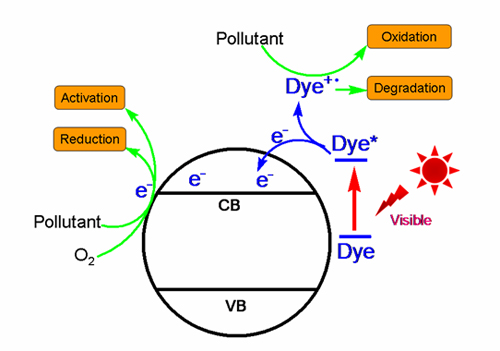Under the long-term supports of the National Natural Science Foundation of China, the Chinese Ministry of Science and Technology, and the Chinese Academy of Sciences, the researchers in the Key Laboratory of Photochemistry of Chinese Academy of Sciences paid a great effort on the semiconductor-mediated photodegradation of pollutants under visible-light irradiation, and made a series of progresses. Recently, they were invited to introduce their achievements in this field in the famous review journal of the Royal Society of Chemistry: Chemical Society Reviews (2010, 39, 4206-4219).
The environmental contamination caused by organic pollutants is becoming an overwhelming problem all over the world. The UV-based photocatalytic degradation of the organic pollutants have been proved to be one of the most promising methods for removal these pollutants. However, considering that the visible light accounts for about 50% of solar energy, it is more desirable to explore new technique that uses visible light, instead of UV light, as the energy source for the degradation of the organic pollutants.
A research group in Institute of Chemistry, directed by Prof. ZHAO Jincai, has carried out a project on the visible-induced degradation of pollutants since 1995. They found that the semiconductor and the surface-adsorbed antenna molecule (dyes or other color species) can constitute efficient photochemical systems for environmental remediation. The excited dye can inject electrons into the conduction band of the semiconductor after absorbing visible light. The chemical reactions following such a charge separation are able to activate both the pollutants and the molecular oxygen (O2), and eventually lead to the efficient degradation of the pollutants. This process extends the photo-response of wide-band-gap semiconductor such as TiO2 from the UV to the visible region, and opens a unique route to use visible light from the sun. Further, such a degradation pathway is completely different from the UV-based photocatalytic degradation. No band-to-band excitation of semiconductor and no hole on the valence band of the semiconductor are involved in the visible degradation process.
This degradation principle can be used to eliminate the dye organic pollutants from water and can be also extended to oxidize or reduce the colorless organic pollutants. In addition, this degradation pathway under visible light irradiation could play a prominent role in transformation fate and effect of environmental organic matters, particularly the organic pollutants. The original findings have been published on, such as, J. Am. Chem. Soc., Angew. Chem. Int. Ed., Environ. Sci. Technol.

Semiconductor-mediated photodegradation can be a promising method to remove environmental pollutants from water by using visible light from the sun as energy. (Image by ZHAO Jincai et al.)
